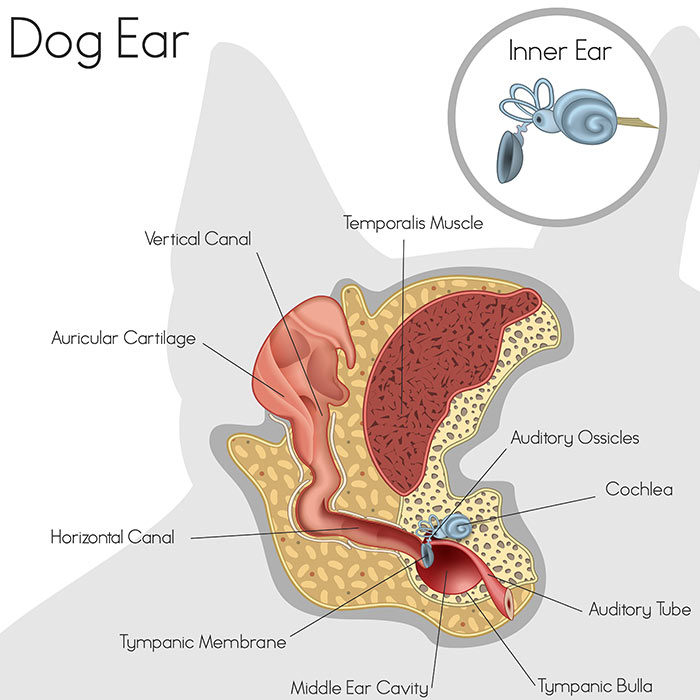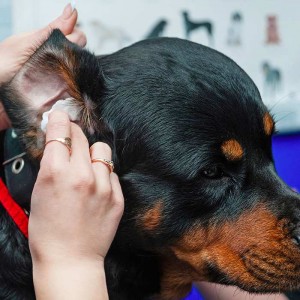Ear infections in dogs and cats
What is otitis externa or ear infection in dogs and cats?
Otitis externa is a common disorder of the ear in dogs and cats. It is not a disease but a collection of symptoms that are secondary to a disease or infection.
 Otitis externa in dogs and cats is an inflammation of the layer of cells that line the external ear canal. The ear canal is the tubular portion of the outer ear that carries sound to the eardrum. The shape of the ear canal in dogs and cats is deep and curved, allowing dirt, wax and moisture to accumulate.
Otitis externa in dogs and cats is an inflammation of the layer of cells that line the external ear canal. The ear canal is the tubular portion of the outer ear that carries sound to the eardrum. The shape of the ear canal in dogs and cats is deep and curved, allowing dirt, wax and moisture to accumulate.
Otitis externa occurs when the environment within the ear canal changes and the canal lining swells and secretes excess wax. The ear canal gradually narrows as excessive fibrous tissue is produced. The canal and the external ear, or pinna, become painful, itchy and red, and if left untreated, can lead to otitis media (inflammation of the middle ear) or potential rupture of the eardrum.
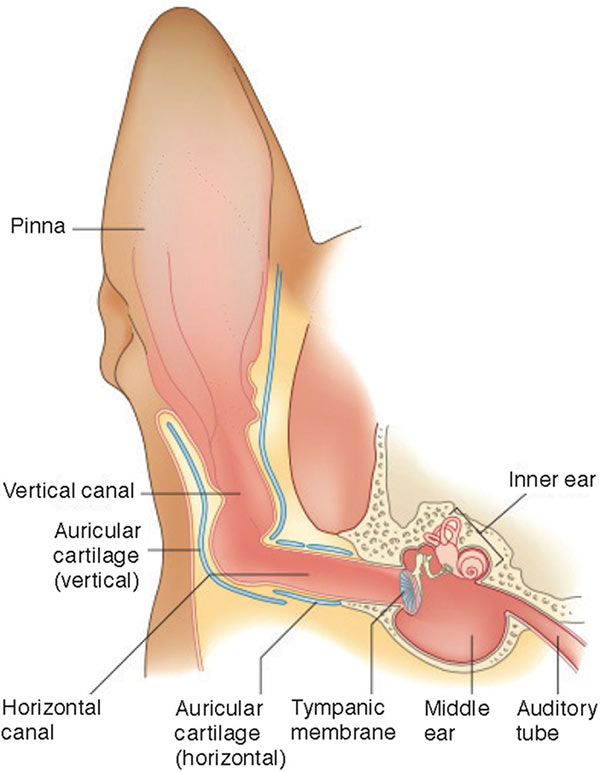
Otitis externa in dogs, canine ear, Otitis externa in cats, cat’s ear https://inpractice.bmj.com/content/38/Suppl_2/2
Cost of ear infection treatment for dogs and cats
Ear infections were one of the most common health issues experienced by dogs and cats in 2022, according to PetSure claims data.
Claims data for ear infections |
Average cost of treatment |
Highest cost of treatment |
| Dogs | $315 | $16,670 |
| Cats | $347 | $7,771 |
Because it is difficult to predict the costs of veterinary care, it can help to have measures in place to help prepare for the unexpected. Pet insurance can help by covering a portion of the eligible vet bill if the unexpected does happen.
Get a quote for 2 months free pet insurance for your puppy or kitten in their first year.
Symptoms of otitis externa in dogs and cats
Otitis externa can affect one or both ears, and can be severe and sudden in onset, or intermittent and chronic.
Common symptoms of otitis externa in dogs and cats are:
- Head shaking
- Ear scratching
- Itchiness
- Redness of the skin
- Scaly skin
- Unpleasant odour coming from the ear
- Swelling
- Self-trauma to the ear, from scratching
- Aural haematoma from severe head shaking
- Discharge from the ear
- Signs of pain
Unsure how serious it is?
Bow Wow Meow policyholders can get access to trusted vet care anytime, anywhere, at no additional cost. Connect to an experienced Australian registered vet via video call, 24/7. Whether it’s providing vet advice, setting up at-home treatment plans, or confirming if you need to visit a vet in person, you can get help when you need it.
Find out more about our pet insurance cover options.
Causes of otitis externa in dogs and cats
There are many factors that can directly or indirectly cause otitis externa in dogs and cats, and a variety of these may play a role in each case. Some of these factors appear to directly cause the inflammation, while others worsen and perpetuate the condition. Additionally, the shape or form of the pinnae and ear canals can predispose some breeds to developing otitis externa.
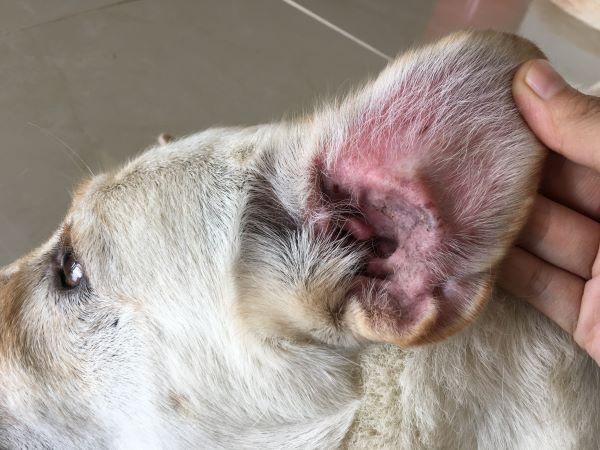
Top 5 dog breeds with ear infections in 2022*:
Primary factors directly causing the inflammation of the ear canal in cats and dogs:
Typically, the primary factor causes a change in the microclimate within the ear canal that enables the growth of certain organisms and leads to infection.
- Allergies are the most common primary cause, for example:
- Atopic dermatitis (hypersensitivity to environmental allergens, such as house dust, grass and moulds)
- Contact dermatitis (an inflammatory skin disease caused by contact of the skin with a chemical)
- Dietary allergies
- Parasites – ear mites, ticks
- Foreign bodies – grass seeds, grass awns (sharp grass seeds that can burrow into the skin)
- Some autoimmune diseases
Perpetuating factors preventing the resolution of otitis externa once it develops:
A secondary infection often develops in response to the primary cause of the inflammation of the ear canal, making the problem much worse. This are called a perpetuating factor. Perpetuating factors are not the cause of the inflammation but develop after inflammation sets in and the microclimate within the ear changes.
Examples of perpetuating factors of otitis externa in cats and dogs are:
- Bacterial infections
- Fungal infections
- Inappropriate use of topical treatments
- Ear pathology, such as ulceration, thickened or folded canals
- Otitis media
Predisposing factors that increase the risk of developing the disease:
A moist, dirty and poorly ventilated ear canal provides the ideal environment for the growth of bacteria, yeast and fungi and the development of infections. Predisposing factors for otitis externa in cats and dogs include:
- The shape of the ear canal – the ear canal of cats and dogs is deep and curved, allowing dirt, wax and moisture to accumulate
- Breed susceptibility – especially among Spaniels and other dog breeds with long floppy ears that cover the canal opening restricting airflow and trapping moisture
- Excess hair inside the ear canals, common in poodles and terriers, can also cover the canal opening, restricting airflow and trapping moisture
- Excess wax production in the ear canals
- Environment – a climate of high humidity and high temperature
- Maceration (soft, soggy skin) – from frequent wetting of the ears while swimming, bathing or hosing
- Trauma – usually from inappropriate cleaning
- Concurrent systemic disease – for example, pyrexia
- Tumours, polyps, cysts – more common in cats
How is otitis externa diagnosed?
The diagnosis of otitis externa in dogs and cats is very similar. If you observe discharge from your dog or cat’s ear or any of the other symptoms listed above, you will need to pay a visit to your vet. It is vital to correctly identify and treat the cause of your dog or cat’s otitis externa; if not, the condition may recur.
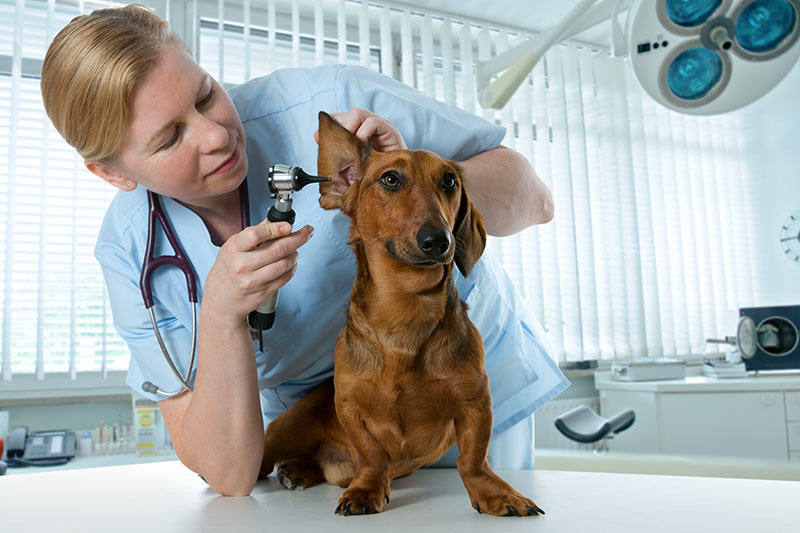
The vet may perform a combination of the following diagnostic procedures, depending on the severity of the condition:
- Take a detailed history, including any exposure to chemicals and irritants
- Perform a physical examination of the ears:
- Visual examination of the ears will help determine if this is a chronic problem, which is indicated by deformities of the pinnae, an abnormal growth of tissue in the canal and head-shaking.
- Examination with an otoscope (a medical instrument which is used to look into the ears) will reveal any primary factors which may have caused the otitis externa in your cat or dog. Use of an otoscope may require sedation or anaesthesia, particularly if the ear is painful or the animal is uncooperative. Otoscopic examination can reveal:
- A mass or obstruction
- Impacted debris
- Foreign objects lodged in the ear canal
- Parasites
- Ruptured or abnormal eardrums
- Disease or rupture of the tympanic membrane
- Take a tissue smear:
- For examination under microscope, to identify any infection-causing microbes (a small number of harmless micro-organisms in the outer ear of most dogs and cats is normal, but if the environment of the ear changes, they can multiply and cause an infection)
- For culture, to determine the flora or bacteria present in the ear
- Perform biopsies:
- to reveal if there is a tumour if there is chronic, obstructive inflammation of one external ear canal ear only
- of any mass observed
- Radiography (x-rays) if better visualisation of the eardrum is required:
- if middle or inner ear infection is suspected
- to identify chronic changes to the ear canal
- or if neurological signs, such as loss of balance, are present
- Allergy testing, if an allergy is suspected, to provide a long-term means of control.
- Examination of any discharge from the ear for eggs, larvae or ear mites (a dark discharge usually indicates a yeast infection, a parasite or a bacterial infection).
- Hair samples for ringworm tests.
Prognosis
Unless all the causes are identified and treated, otitis externa is likely to recur. After thorough investigation, your vet can determine whether it can be cured or if long-term or life-long treatment is necessary. With appropriate treatment, acute cases of otitis externa in dogs and cats usually take two to four weeks to resolve. Chronic cases can take months to clear up, and treatment may need to continue for the rest of the animal’s life.
Treatment for otitis externa in dogs and cats
The treatment and preventive care for dogs and cats with otitis externa is very similar, with the aim being to correct or eliminate all underlying predisposing, primary and perpetuating factors. Any pain should also be managed.
Treatment may include a combination of the following:
Medication:
Otitis externa is usually treated by putting drops or ointment directly into the affected ear. Oral medication may also be prescribed, particularly if there has been ongoing inflammation of the ear canal or suspected middle ear inflammation. Treatment may include:
- Ear drops or ointment to apply directly to the affected ear (when applied properly, these will coat the layer of cells that line the external ear canal with a thin film), such as:
- Antibiotic to kill harmful bacteria
- Antifungal to kill fungi or yeasts
- Antiparasitic to kill ear mites (this may need to be applied to the entire body, as areas other than the ears can be infected; all in-contact animals should be treated)
- Anti-inflammatory to reduce pain and swelling
- A cleaning treatment to remove excess dirt, wax and discharge from the ear canal, so that the drops or ointment can properly penetrate the ear canal
- Oral corticosteroids can be given for a short period at a high dose to open constricted canals and increase the effectiveness topical treatment
- Oral antibiotics to treat bacterial infections
- Oral anti—inflammatory tablets for pain
Other treatment options may include:
- Removal of hair:
- from the outer ear, to improve the cleaning and treatment of the ears
- sometimes from the ear canal, to improve ventilation and access for treatment. This is a painful procedure, usually done under anaesthesia
- Thorough cleaning of the ear to remove discharge and earwax, initially in the clinic, possibly under anaesthesia.
Surgical treatment for severe, recurrent, chronic and end-stage otitis externa cases:
- Lateral Wall Resection:
- To increase drainage and ventilation of the external ear canal
- It may be performed where otitis has recurred despite appropriate medical management
- Total Ear Canal Ablation and Lateral Bulla Osteotomy:
- This entails complete removal of all external ear tissue except the pinna, as well as removal of infected tissue within the middle ear
- It is a salvage procedure that should only be performed in otitis externa cases that are chronic and end-stage
- It can also be performed if otitis externa is still present following a lateral wall resection.
Preventative measures
- The ear canals should be kept dry and well ventilated – consider using astringents or drying agents in the ears of dogs who swim frequently, to minimise softening of the ear canal and decrease the frequency of bacterial or fungal infections forming in moist ear canals.
- Clean your pet’s ears initially before every treatment, and then clean regularly once or twice a week indefinitely.
- Regularly pluck hairs from the inside of the ear to improve ventilation and decrease humidity in the ears, if recommended by the vet.
- Do not apply anything to the ear that has not been recommended by your vet, such as home remedies or powders, as these can irritate an already-inflamed ear.
In summary
Otitis externa is an inflammation of the external ear canal and is a common ear complaint in dogs and cats. Otitis externa can be a very painful and distressing condition that will not resolve by itself. Untreated, it can lead to serious problems such as middle ear infections.
Otitis externa can be caused by a variety of factors, including parasites, allergies, foreign bodies, which create an environment in which infections can set in. It is important to identify and address the primary, perpetuating and predisposing factors to avoid chronic disease. Follow your veterinarian’s recommended treatment program carefully and completely, as otitis externa has a high likelihood of recurring.
Bow Wow Meow Pet Insurance can help protect you and your pet should an unexpected trip to the vet occur.
-
Find out more about our dog insurance options
-
Find out more about our cat insurance options
-
Get an instant online pet insurance quote


More information
https://www.msdvetmanual.com/cat-owners/ear-disorders-of-cats/otitis-externa-in-cats







